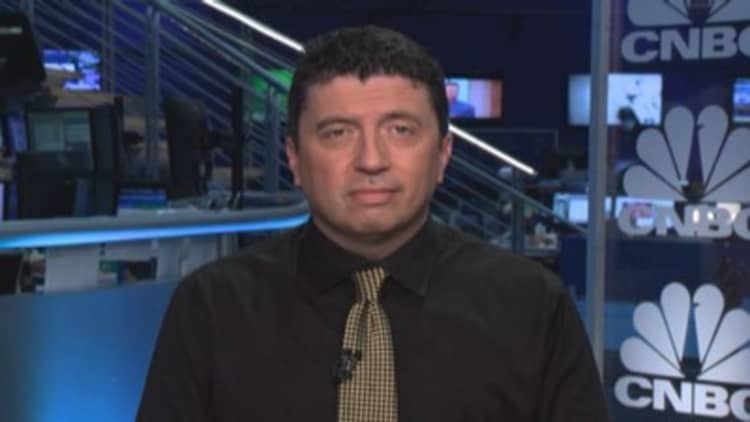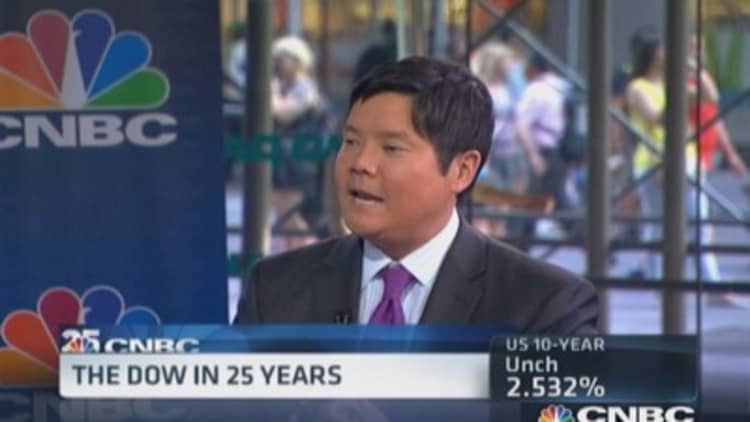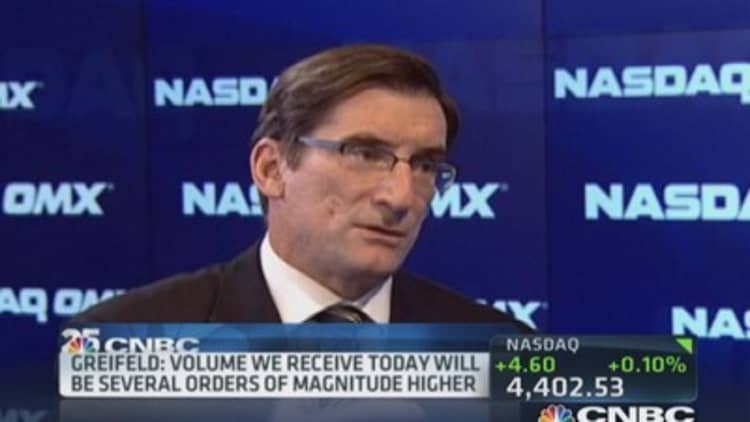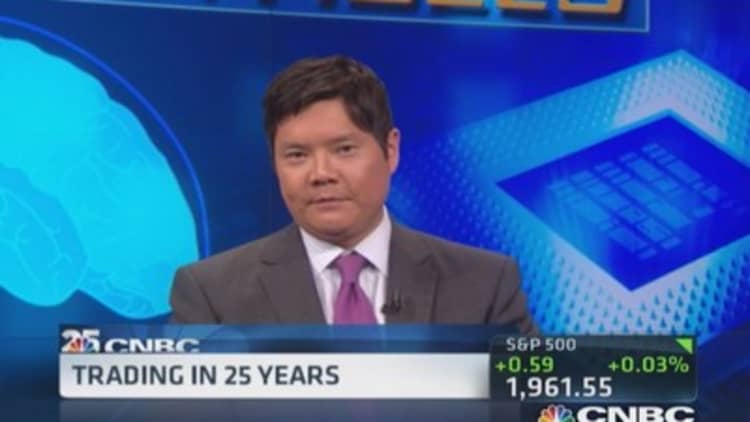




Nassim Taleb would have to be on anyone's list of the top market prognosticators over the past 25 years, but the honor drips with irony.
Taleb, after all, is best known for making something akin to a prediction in a book that railed against predicting.
In his book "The Black Swan: The Impact of the Highly Improbable," the author and New York University professor warned against the inability to foresee unusual events that have severe consequences. The book was published in 2007, just as the financial industry was beginning to crumble under the weight of toxic bets on home loans to low-quality borrowers.
After its release, Taleb was hailed as a visionary for seeing that the financial system was dangerously interconnected and that giant institutions posed grave dangers.
But he warned repeatedly against investors relying on market and economic soothsayers whose proclamations usually emanated from severe cases of collective thinking and confirmation bias.
"Our predictors may be good at predicting the ordinary, but not the irregular, and this is where they ultimately fail. ... What matters is not how often you are right but how large your cumulative errors are," Taleb wrote.
"And these cumulative errors depend largely on the big surprises, the big opportunities. Not only do economic, financial and political predictors miss them, but they are quite ashamed to say anything outlandish to their clients—and yet events, it turns out, are almost always outlandish. Furthermore …economic forecasters tend to fall closer to one another than to the resulting outcome. Nobody wants to be off the wall."
Yet the financial markets are littered with forecasters, most with either an outwardly bullish (optimistic) or bearish (pessimistic) bias. Most of them missed the financial crisis when it hit by being too bullish, and some have been too bearish since, worrying that another systemic collapse is around the corner when in fact equity markets, at least, continue to zoom to new highs.
Indeed, there have been some great calls and some awful ones over the past 25 years. Here is a look at some of them, in no particular order:
Five that worked
1. Robert Shiller's triple bubble burst. All seemed well with the world in the mid- to late-1990s as this new thing called the World Wide Web was making millionaires and billionaires faster than you could say "dot-com." Yale economist Shiller was having none of it, though, correctly surmising in his 2000 book "Irrational Exuberance" that Pets.com and the rest of the digital Wild West was poised for a fall. Five years later, he released the book's second edition, predicting that housing values had gotten out of whack and were about to blow. And he wasn't finished yet: In 2007 Shiller forecast a collapse of the U.S. real estate market and an ensuing financial panic. At long last—finally!—in 2013 the Nobel Committee got around to giving Shiller (along with two others) its coveted prize for economics.
2. Meredith Whitney finds blight in Citi. When the chips started to fall in the financial crisis, Whitney was a little-known and lightly regarded analyst at Oppenheimer. By the time the banking collapse was in full vigor, she was a Wall Street rock star with cover-girl looks who eventually opened her own firm and was in demand everywhere. On Halloween 2007 she said Citigroup would have to cut its dividend to deal with billions in losses from toxic assets—the shot across the bow for the collapse of the subprime mortgage market and the worst economic downturn since the Great Depression. She followed that call with several years' worth of bearish predictions about banks and the economy. As it all unfolded, Whitney was the subject of multiple fawning media profiles and dozens of closely followed appearances on business news outlets. Then one wintry Sunday night she appeared on "60 Minutes" and ... well, we'll talk more about that in a minute.
3. Nouriel Roubini sees subprime doom. In a speech to the International Monetary Fund in September 2006, "Dr. Doom" warned about the coming crash. The ecomomicpredictions.org site rates claims—true and false—from those who profess to have foreseen the crisis and deems the following Roubini statement to the IMF as "uncanny" in its prescience: "And my concern today is that the bursting of the housing bubble—we have not seen it yet—is going to lead to broader systemic banking problems. It is going to start with the subprime lenders—they are already in trouble because of increases in delinquencies and foreclosures—and then it is going to be transmitted to other banks and financial institutions all over the country." Roubini's track record, however, is far from perfect, a fate that has met many of the financial-crisis superstars. More on that below.
4. Elaine Garzarelli's 'Black' vision. Yes, we know the math isn't quite right here—that this call actually happened 27 years ago. But no serious discussion about modern-day prognostication can exclude Garzarelli. As the stock market was roaring in 1987, one Wall Street analyst was getting bearish—seriously bearish. Working for Shearson Lehman Brothers at the time, Garzarelli said the market was 35 percent overvalued and she had a bad feeling about where things were headed.
In a later interview, with Fortune, Garzarelli recounted the fallout of her legendary call that preceded Black Monday. "I felt awkward because I got so much attention. A few weeks after that, I made a negative comment, and the market dropped 120 points that day. The Wall Street Journal wrote that I had moved the stock market, and I was very uncomfortable. My career was going very nicely until then, and it was too much attention. It was a lot of pressure. But the crash didn't shape the way I look at the market at all. It gave me even more confidence that the indicators are very good—that I should stick to them no matter what." There's a perception that Garzarelli sort of faded into the background after losing her job at Lehman Brothers in the early 1990s, but that's not true. She's continues to run a wealth management firm and puts out forecasts. She has been (correctly) bullish on the market for several years.
5. John Paulson, the "greatest" of them all. This isn't necessarily a "call" per se, as Paulson's stunningly farsighted wager against the subprime housing market went fairly under the radar until Gregory Zuckerman immortalized it in the 2010 book "The Greatest Trade Ever." Though Paulson wasn't alone in his subprime skepticism, his $15 billion haul from the trade put him at the front of the pack. Other investors knew what he was up to but scoffed at him. Ultimately, Paulson would stay a little too long at the table in his wagering against housing, but he remains one of the most highly regarded hedge fund honchos today. (There was one unfortunate coda to the Paulson trade: Goldman Sachs, which bundled mortgage bonds into a portfolio that Paulson bet against, would have to pay $550 million in fines after the Securities and Exchange Commission said the firm misled investors on the other side of the Paulson trade.)
Honorable mentions: Mark Haines, the late CNBC anchor, calls the market bottom in March 2009; George Soros shorts the British pound in 1992; Peter Schiff also calls the financial crisis in 2006; David Tepper kicks off the "Tepper Rally" on CNBC in September 2010 by putting his faith in the Fed.
And three that flopped
1. Whitney whiffs on munis. Truth be told, Whitney was probably always overrated. Even during her heyday in the latter part of the aughts decade, Whitney was ranked 1,205th out of 1,919 equity analysts in 2007 and 919th out of 1,917 in the first half of 2008, according to Fortune. So all the fanfare over her market-calling ability almost seemed destined to end badly. And so it was that in late December 2010, she was featured on CBS's "60 Minutes" and made the call heard round the fixed-income world: A prediction that 50 to 100 municipal bond defaults would cause "hundreds of billions" in losses that immediately moved markets but ultimately would be proven badly unfounded.
In fairness to Whitney, the muni space has not been without its high-profile defaults, but the situation has not approached her dire forecast. In her mostly overlooked 2013 book, "Fate of the States: The New Geography of American Prosperity," Whitney only briefly mentioned the muni call, maintaining that the media overhyped her remarks. Despite the high profile she cultivated, Whitney also protested in the book that she didn't like that her name had "become synonymous with doom and gloom." Nowadays, her name is mostly synonymous with a very bad bonds call, and her public profile has dimmed significantly.
2. Cohen: Crisis? What Crisis? Face it, almost everybody on Wall Street missed the financial crisis. But you would be hard-pressed to find a major analyst at a major Wall Street shop caught more unaware than Abby Joseph Cohen, the Goldman Sachs chief strategist who still had her rally cap on well into 2008 as the market imploded. Cohen set an uberbullish 1,675 price target for the S&P 500 for that fateful year, not foreseeing that the world was crumbling before her eyes. The stock market index would close at 903.25, a 37 percent drop and 46 percent below Cohen's target. That same year, Goldman replaced Cohen with David Kostin and moved her over to a position as "senior investment strategist." Yet on Wall Street there's always room for a second act: Cohen maintains a prominent role at Goldman and even was selected to go first at a recent high-profile question-and-answer session with Federal Reserve Chair Janet Yellen.
3. Helicopter Ben's "contained" crisis. Most accounts of financial-crisis history no doubt will paint then-Federal Reserve Chairman Ben Bernanke as one of the central figures on the Committee to Save the World, as it was nicknamed. But it was also Bernanke's seeming obliviousness to the dangers of subprime mortgages that helped stoke the debacle in the first place. In a speech given March 28, 2007, before the Joint Economic Committee, the central bank chief showed just how deep the denial ran over the coming crisis: "Although the turmoil in the subprime mortgage market has created severe financial problems for many individuals and families, the implications of these developments for the housing market as a whole are less clear," he said. "At this juncture, however, the impact on the broader economy and financial markets of the problems in the subprime market seems likely to be contained. In particular, mortgages to prime borrowers and fixed-rate mortgages to all classes of borrowers continue to perform well, with low rates of delinquency."
The statement would soon prove to be tragically shortsighted, though the Fed ultimately would join with the Treasury Department to devise trillions of dollars' worth of alphabet-soup programs that bailed out the financial, insurance and auto industries, paving the way for a recovery—albeit grudgingly slow—that continues today.
Honorable mentions: "Dow 100,000" by 2020, according to the 1999 book by Charles W. Kadlec (yes, we know it's not 2020 yet, but seriously?); Marc Faber, Schiff and all of the perma-bears (a group from which Roubini has only recently extricated himself) who have been fighting the market all the way up from its March 2009 lows; Whitney Tilson's 2004 prediction that Google would be "highly disappointing" to investors.





